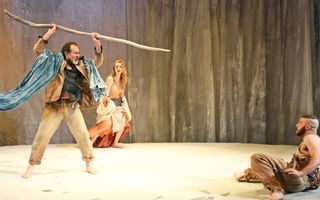 Watch
Watch
Despite the lyrical and poetic beauty of the play, it is impossible to ignore the fact that the play’s reception over time, and the conversation surrounding it, has been altered by ever-changing racial theories and evolving cultural awareness.
We can only speculate what Shakespeare’s intentions were when he crafted the colonised characters of this text, and how a 17th-century audience would have perceived them. Firstly, Caliban is most likely a play on the word ‘cannibal’, and is often viewed as Shakespeare’s representation of a ‘primitive’ human, who is both untamed and lustful. Caliban is often described in the play as a monster, “not borne of a human shape” (Act 1, Scene 2), “half a fish and half a monster” (Act 3, Scene 2), and on whose “nature, nurture can never stick” (Act 4, Scene 1). Such quotes seem to present native man to be so beastly that he is untamable. From the opening scenes Caliban is beaten into submission, and when the play concludes, he is forced to apologise for any resistance he showed his ‘master’. However, these actions and descriptions are not necessarily Shakespeare’s, but rather those of his flawed characters functioning in the midst of emerging colonialism.
So, was Shakespeare using them to make a moral comment? While we can’t be sure, what is undeniable is what Shakespeare affords Caliban. Caliban not only speaks in poetic, eloquent, intelligent verse, but is provided a chance on stage to challenge his master who taught him ‘civilised’ ways, but simultaneously gave him no power to practise them: “You taught me language, and my profit on’t / Is, I know how to curse” (Act 1, Scene 2). Caliban is presented as having a deeper understanding of the island and a richer connection with nature than the often ignorant European visitors, to whom he showed great hospitality until they ungratefully enslaved him. What is most touching is the resentment he expresses when he talks of his lands being taken from him.
Scholars claim that the ambiguous descriptions of Caliban in the text have actually allowed for various portrayals of the role throughout the play’s production history. Early depictions are believed to have pandered to the growing obsession with the strangeness of New World inhabitants, and so they dressed Caliban as bizarrely as possible. From the mid-1800s the theories of Darwin exerted a great influence on the way Caliban was seen. In other writings of this era, poets explored the world from Caliban’s point of view: some authors even saw him as Darwin’s missing link between man and animal. From the 1890s onwards there was a school of criticism that drew parallels between the island and the English colonisation of the Americas at the time (i.e Virginia), with Caliban representing the native American.
With the publication of Prospero and Caliban: The Psychology of Colonization, by Octave Mannoni in the 1950s, and the rise of post-colonial theory, the role of Caliban would be forever reimagined. In the 1950s and 60s Caliban was re-cast as the slave or Indigenous inhabitant railing against the arrogant imperialist Prospero, most notably in adaptations like Aimé Césaire’s 1969 play Une Tempête, set in the Caribbean. For post-colonial theorists Prospero in many ways presents the qualities of the coloniser. He strongly believes he has brought light and knowledge to Caliban’s darkness and ignorance. Prospero praises himself for bestowing gifts and knowledge upon Caliban, having taken ‘pains to make thee speak’ (Act 1, Scene 2), and when Caliban resists or retains any of his past identity or practices Prospero considers him ungrateful.
Modern depictions of Caliban are continually emerging, and they still give a voice to many colonised Indigenous cultures. Since the 1990s several Australian productions have cast Caliban as Indigenous, beginning with Neil Armfield’s 1995 production casting actor Kevin Smith, and the Queensland Theatre Company’s 1999 production starring Glen Shea. The first black actor to play the role of Caliban was Canada Lee in a New York production in 1945. Prior to this, the common practice was to cast a white actor who would use blackface to depict the role. Historians speculate that even early 17th-century productions of The Tempest would have used blackface as it was a recorded practice of the time. And despite the fact that The Tempest has now become a vehicle for social change and Caliban a positive symbol for the colonised, productions still cast him in blackface well into the late 20th century.






